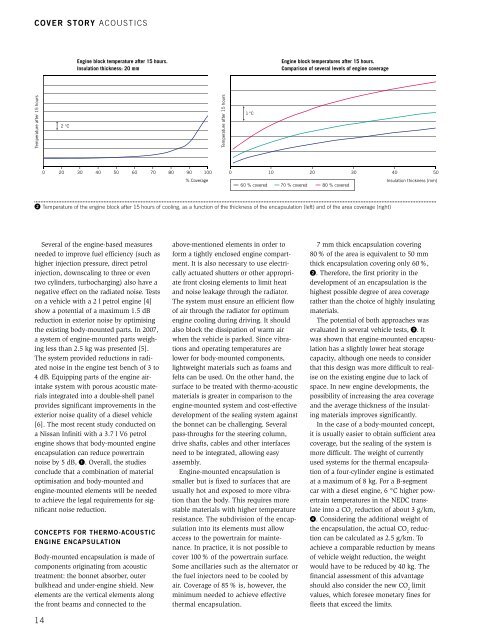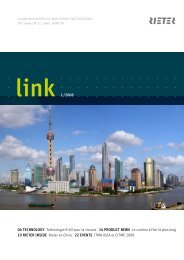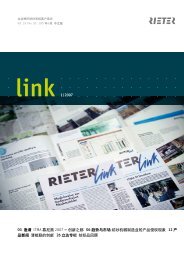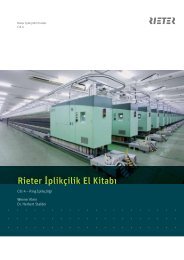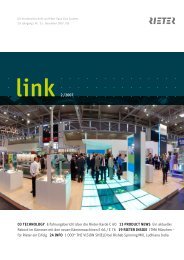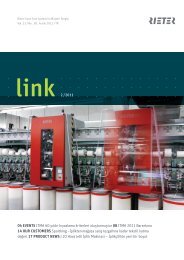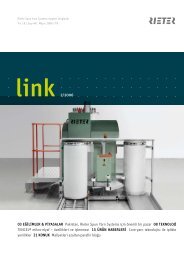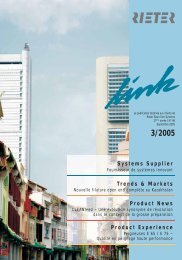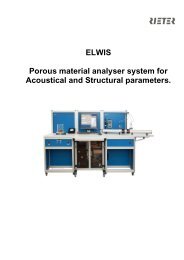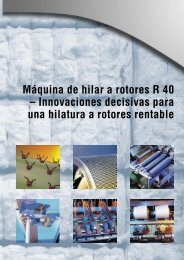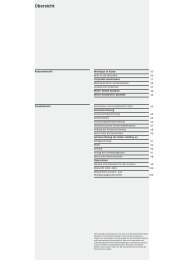Cover Story ACOusTiCs - Rieter
Cover Story ACOusTiCs - Rieter
Cover Story ACOusTiCs - Rieter
You also want an ePaper? Increase the reach of your titles
YUMPU automatically turns print PDFs into web optimized ePapers that Google loves.
<strong>Cover</strong> story <strong>ACOusTiCs</strong><br />
Temperature after 15 hours<br />
2 °C<br />
Engine block temperature after 15 hours.<br />
Insulation thickness: 20 mm<br />
0 20 30 40 50 60 70 80 90 100<br />
Several of the engine-based measures<br />
needed to improve fuel efficiency (such as<br />
higher injection pressure, direct petrol<br />
injection, downscaling to three or even<br />
two cylinders, turbocharging) also have a<br />
negative effect on the radiated noise. Tests<br />
on a vehicle with a 2 l petrol engine [4]<br />
show a potential of a maximum 1.5 dB<br />
reduction in exterior noise by optimising<br />
the existing body-mounted parts. In 2007,<br />
a system of engine-mounted parts weighing<br />
less than 2.5 kg was presented [5].<br />
The system provided reductions in radiated<br />
noise in the engine test bench of 3 to<br />
4 dB. Equipping parts of the engine airintake<br />
system with porous acoustic materials<br />
integrated into a double-shell panel<br />
provides significant improvements in the<br />
exterior noise quality of a diesel vehicle<br />
[6]. The most recent study conducted on<br />
a Nissan Infiniti with a 3.7 l V6 petrol<br />
engine shows that body-mounted engine<br />
encapsulation can reduce powertrain<br />
noise by 5 dB, 1. Overall, the studies<br />
conclude that a combination of material<br />
optimisation and body-mounted and<br />
engine-mounted elements will be needed<br />
to achieve the legal requirements for significant<br />
noise reduction.<br />
ConCePts For tHermo-aCoustiC<br />
engine enCaPsuLation<br />
Body-mounted encapsulation is made of<br />
components originating from acoustic<br />
treatment: the bonnet absorber, outer<br />
bulkhead and under-engine shield. New<br />
elements are the vertical elements along<br />
the front beams and connected to the<br />
% <strong>Cover</strong>age<br />
Temperature after 15 hours<br />
1 °C<br />
above-mentioned elements in order to<br />
form a tightly enclosed engine compartment.<br />
It is also necessary to use electrically<br />
actuated shutters or other appropriate<br />
front closing elements to limit heat<br />
and noise leakage through the radiator.<br />
The system must ensure an efficient flow<br />
of air through the radiator for optimum<br />
engine cooling during driving. It should<br />
also block the dissipation of warm air<br />
when the vehicle is parked. Since vibrations<br />
and operating temperatures are<br />
lower for body-mounted components,<br />
lightweight materials such as foams and<br />
felts can be used. On the other hand, the<br />
surface to be treated with thermo-acoustic<br />
materials is greater in comparison to the<br />
engine-mounted system and cost-effective<br />
development of the sealing system against<br />
the bonnet can be challenging. Several<br />
pass-throughs for the steering column,<br />
drive shafts, cables and other interfaces<br />
need to be integrated, allowing easy<br />
assembly.<br />
Engine-mounted encapsulation is<br />
smaller but is fixed to surfaces that are<br />
usually hot and exposed to more vibration<br />
than the body. This requires more<br />
stable materials with higher temperature<br />
resistance. The subdivision of the encapsulation<br />
into its elements must allow<br />
access to the powertrain for maintenance.<br />
In practice, it is not possible to<br />
cover 100 % of the powertrain surface.<br />
Some ancillaries such as the alternator or<br />
the fuel injectors need to be cooled by<br />
air. <strong>Cover</strong>age of 85 % is, however, the<br />
minimum needed to achieve effective<br />
thermal encapsulation.<br />
Engine block temperatures after 15 hours.<br />
Comparison of several levels of engine coverage<br />
0 10 20 30 40 50<br />
60 % covered 70 % covered 80 % covered<br />
2 Temperature of the engine block after 15 hours of cooling, as a function of the thickness of the encapsulation (left) and of the area coverage (right)<br />
14<br />
Insulation thickness [mm]<br />
7 mm thick encapsulation covering<br />
80 % of the area is equivalent to 50 mm<br />
thick encapsulation covering only 60 %,<br />
2. Therefore, the first priority in the<br />
development of an encapsulation is the<br />
highest possible degree of area coverage<br />
rather than the choice of highly insulating<br />
materials.<br />
The potential of both approaches was<br />
evaluated in several vehicle tests, 3. It<br />
was shown that engine-mounted encapsulation<br />
has a slightly lower heat storage<br />
capacity, although one needs to consider<br />
that this design was more difficult to realise<br />
on the existing engine due to lack of<br />
space. In new engine developments, the<br />
possibility of increasing the area coverage<br />
and the average thickness of the insulating<br />
materials improves significantly.<br />
In the case of a body-mounted concept,<br />
it is usually easier to obtain sufficient area<br />
coverage, but the sealing of the system is<br />
more difficult. The weight of currently<br />
used systems for the thermal encapsulation<br />
of a four-cylinder engine is estimated<br />
at a maximum of 8 kg. For a B-segment<br />
car with a diesel engine, 6 °C higher powertrain<br />
temperatures in the NEDC translate<br />
into a CO 2 reduction of about 3 g/km,<br />
4. Considering the additional weight of<br />
the encapsulation, the actual CO 2 reduction<br />
can be calculated as 2.5 g/km. To<br />
achieve a comparable reduction by means<br />
of vehicle weight reduction, the weight<br />
would have to be reduced by 40 kg. The<br />
financial assessment of this advantage<br />
should also consider the new CO 2 limit<br />
values, which foresee monetary fines for<br />
fleets that exceed the limits.


